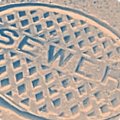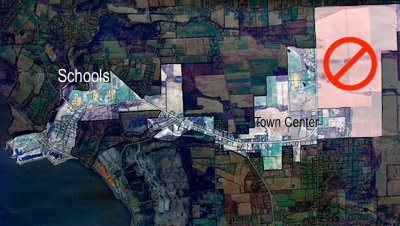- By Dan Veaner
- News
 Print
Print  As plans for the $10.6 million Lansing sewer project begin to take final shape the Sewer Committee is investigating ways to make the project affordable while finalizing the scope of the project. Last week a consultant outlined ways of financing the project that could result in an interest rate as low as 1%. The biggest change in the boundaries of the proposed district is the elimination of Kingdom Farm. Officials plan public meetings to explain the project when the details of the plan are set.
As plans for the $10.6 million Lansing sewer project begin to take final shape the Sewer Committee is investigating ways to make the project affordable while finalizing the scope of the project. Last week a consultant outlined ways of financing the project that could result in an interest rate as low as 1%. The biggest change in the boundaries of the proposed district is the elimination of Kingdom Farm. Officials plan public meetings to explain the project when the details of the plan are set."What's been happening with the sewer has been very fluid," committee member Andy Sciarabba says. "People are saying we should have some public information meetings. We agree with them 100%. But every time we turn around something changes dramatically, so we would hate to give out facts and information and not be fairly close to what the final plan looks like."
Recent changes to the plan have involved the proposed boundary of the district, location of the treatment plant, and ways of financing the project. The balance between the cost to services portions of the town and income provided per Equivalent Dwelling Unity (EDU) drive the affordability of the project. At one point the Sewer Committee considered expanding the proposed district along Triphammer Road south of Peruville Road to include more homes, but two weeks ago decided to stay within the original district boundaries. Once the district is established other areas may elect to join. Only people within the district pay for sewer.
The most dramatic change is the removal of Kingdom Farm from the proposed sewer district. In 1999 the owner of the farm, The Watchtower Society, entered into an agreement with the Town to contribute $1.5 million to a sewer project in exchange for an agreed upon amount of sewer capacity to the property. At that time they were considering building a community to print the Jehovah's Witness Watchtower publication that would include residences as well as the printing facilities. Later the decision was made to locate the facility elsewhere. In May of 2007 the Watchtower Society asked the Town Planning Board to rezone parts of the property to allow them to sell to developers who could create what amounted to a village that included a possible shopping center, businesses, elderly housing, and apartments in the southern portion stepping up to increasingly larger lots for stand-alone homes in the north.
 Kingdom Farm (reddish area to the right) has been removed from the proposed sewer district. Aside from a few minor changes the original district boundaries stand.
Kingdom Farm (reddish area to the right) has been removed from the proposed sewer district. Aside from a few minor changes the original district boundaries stand.Since that time there has been little communication from the Society, and earlier this month the Town Board voted to cancel the agreement. Lansing residents and County officials oppose developing prime farmland in the town -- one of the main purposes of the sewer project is to centralize development in South Lansing to help preserve farmland in the north of the town.
Costs for an SBR sewage treatment plant with a tertiary disk or membrane filtration system will be about $10.6 million. With market rate financing and O&M costs that would bring the first year's bill to $869.08 per per Equivalent Dwelling Unity EDU.
The current project would be well within the affordable range if a $4.2 millon NY State Department of Environmental Conservation (DEC) grant had not been withdrawn in 2008 after the last incarnation of the sewer project failed. Some of the money was diverted to the Warren Road Sewer Project, but the rest went back to the State. Additionally Lansing doesn't qualify for federal and state grants that are available now.
Committee members had been concerned that the project would be too expensive, but became more optimistic after meeting with Municipal Solutions' Jeff Smith last week. Smith outlined innovative ways of financing the project that will reduce costs. Sciarabba says an interest rate as low as 1% could bring that cost down to the low six hundreds, which is within the high-500s / low-600s goal for annual costs per household. He adds that the committee will pursue grants to potentially further reduce the annual cost to residents and businesses within the district, as well as grants to help reduce hook-up costs.
The committee has explored qualifying for a low interest rate with the Environmental Facilities Corporation (EFC), but private funding through renewable BANs or other methods may be more advantageous in obtaining a 1% or lower rate. Lansing currently boasts a triple-A rating that will make town sewer bonds attractive to investors. Sciarabba says that the Town will not only likely get a better interest rate this way, but can finance the project faster, because EFC doesn't announce the scores that loans are based on for competing municipal projects until October. Committee members say they will pursue all options.
Committee members are also working on getting firm commitments from developers to increase the residential EDU count which would lower the cost per EDU and make the project more eligible for favorable interest rates. Two projects proposed by NRP Group for the town center area could add 310 EDUs to the count, while another project proposed for a parcel between Ridge and Wilson Roads could add an additional 58 units.
A map plan and report are being finalized and will be used to submit an initial application to EFC by May 1. Engineer David Herrick has put together a timeline for getting the project approved and built. Sciarabba says it will take about a year before construction can begin, if voters within the proposed district approve the project. If that happens he says the first hook-ups could come as early as 2014.
Long before that happens committee members plan public meetings to explain the project to the public. They say they will hold the meetings as soon as they have solid answers to questions they expect the public to raise.
v8i16



